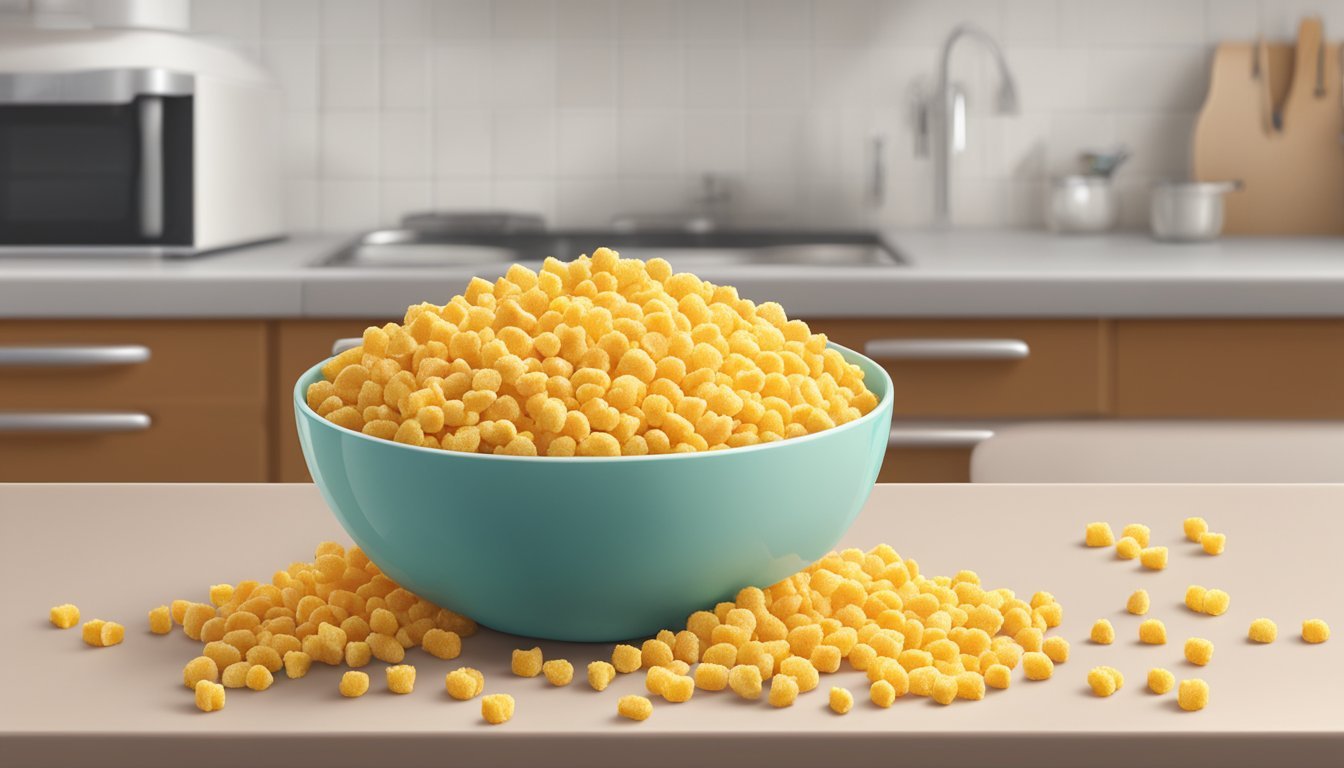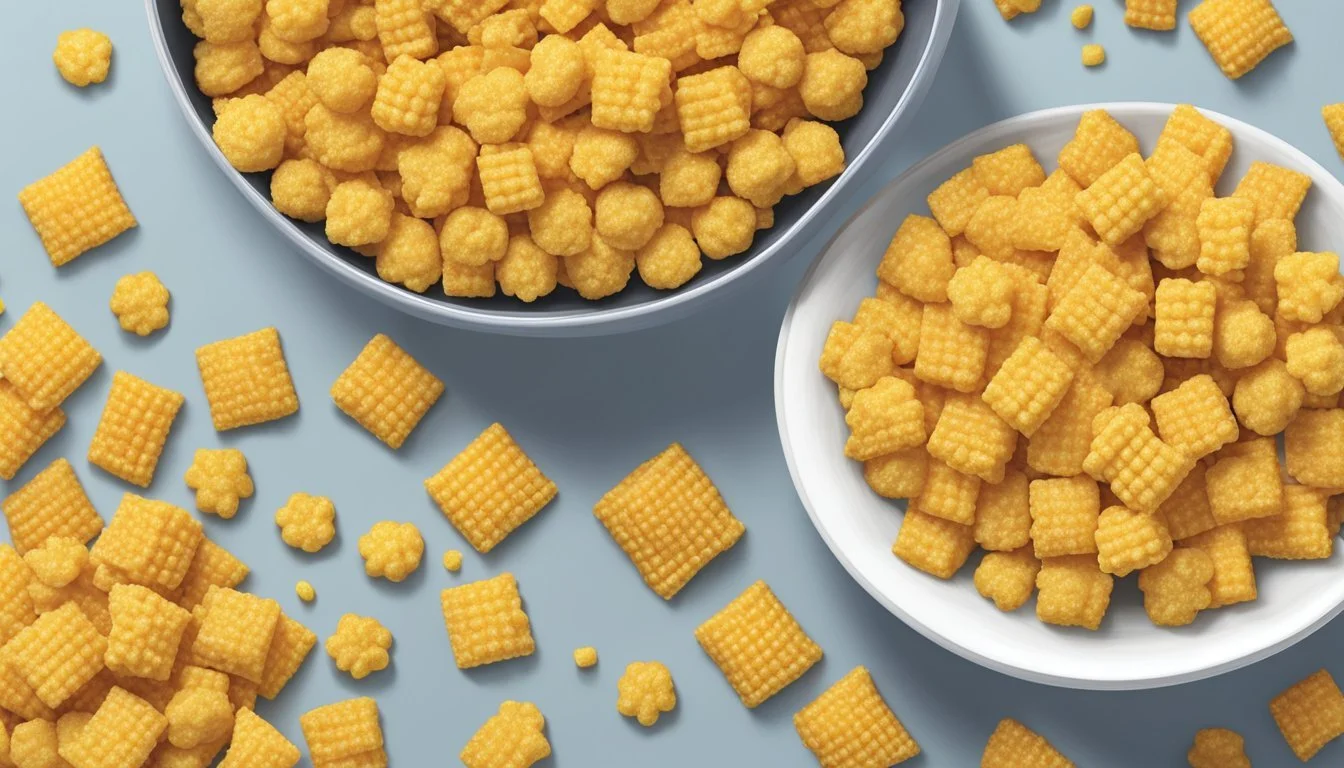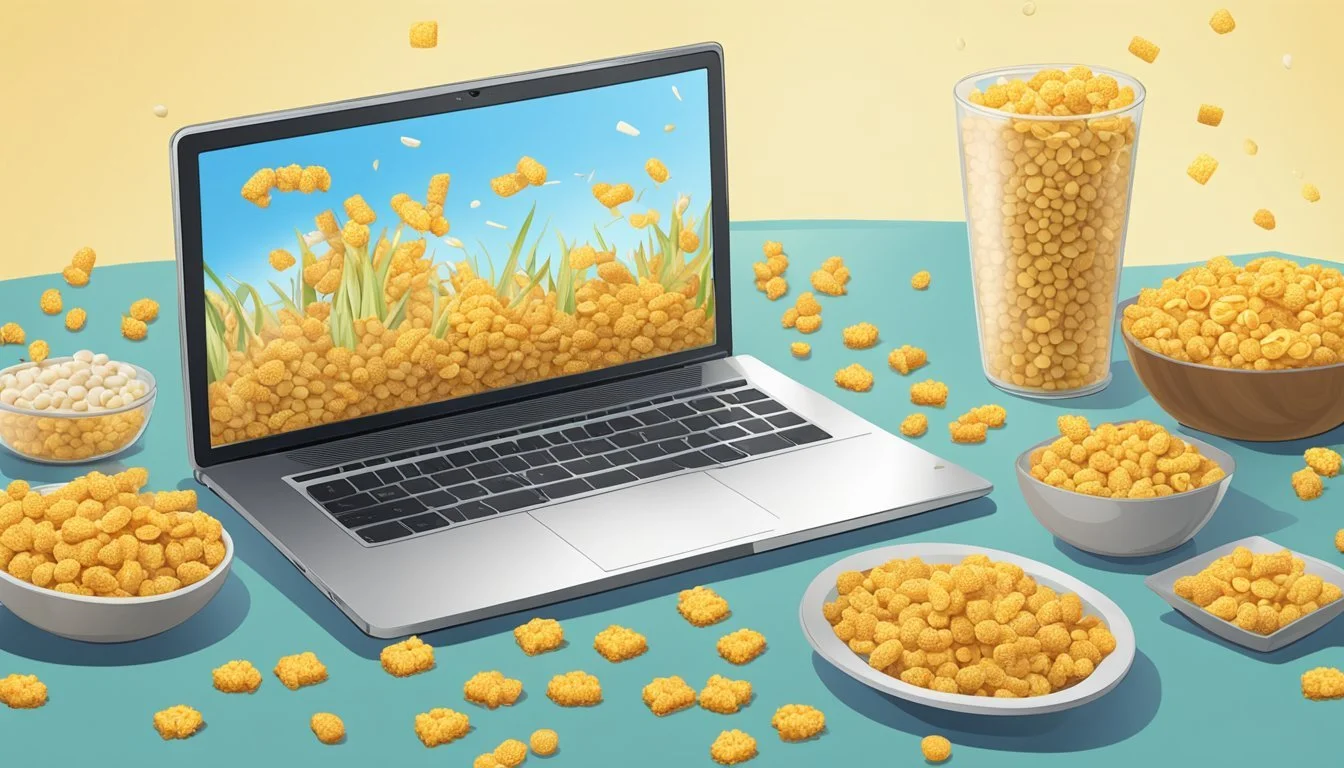Corn Pops vs Crispix
Comparing Flavor, Texture, and Nutrition
This Article is Part of Our Breakfast Cereal Guide with Details on Corn Pops Nutrition and Crispix Nutrition
Choosing the right breakfast cereal can be daunting with so many options available. Among popular choices, Kellogg's Corn Pops and Kellogg's Crispix often stand out. Both cereals offer unique flavors and nutritional benefits, but there are significant differences that could influence your decision.
Kellogg's Corn Pops contains 13.0 grams of complex carbohydrates per serving, whereas Crispix boasts 21.0 grams, providing more sustained energy throughout the morning. Additionally, Crispix is enriched with higher levels of essential vitamins and minerals like Iron, Folate, and Vitamin B6, while Corn Pops falls short in these aspects.
For those mindful of sugar intake, it's important to note that while both cereals contain sugars, Crispix typically offers a more balanced nutritional profile. The choice between Corn Pops and Crispix thus hinges on your specific dietary needs and flavor preferences.
Historical Background
Corn Pops and Crispix, two popular cereals produced by Kellogg's, have distinctive histories that reflect their unique positions in the market. Corn Pops, with a rich backstory dating to the early 1950s, contrasts Crispix's introduction in the 1980s, aimed at rivalling another cereal brand.
Origins of Corn Pops
Corn Pops debuted in 1950 under the name "Corn Pops" before being rebranded multiple times. In 1951, it became "Sugar Corn Pops," highlighting its sweetened nature. By 1978, it adopted the name "Sugar Pops" and then returned to "Corn Pops" in 1984.
Kellogg's Corn Pops Cereal was celebrated for its crunchy texture and sweet flavor. The cereal even sponsored "The Adventures of Wild Bill Hickok" on both radio and television. This era marked the golden age of breakfast cereals, and Corn Pops quickly became a household name. Corn Pops is known for its unique puffed corn texture, which differentiates it from other cereals that often rely on flakes or shapes.
Development of Crispix
Crispix, introduced by Kellogg's in 1983, was specifically designed to compete with Ralston Purina's Chex cereals. Boasting "Crispy rice on one side, crunchy corn on the other," Kellogg's Crispix Cereal offered a dual-texture experience that quickly garnered consumer interest.
By 1987, Crispix had achieved $65 million in sales, capturing a significant market share in a short time. Crispix's launch sought to diversify Kellogg's product offerings and appeal to consumers looking for textural variety. The competition between Crispix and Chex marked an era of innovation and aggressive marketing in the cereal industry.
Nutritional Profiles
Corn Pops and Crispix offer distinct nutritional benefits, essential for making an informed decision based on dietary needs and health goals.
Corn Pops Nutritional Information
Corn Pops contains 0 grams of fat per serving, making it a low-fat option. It includes 90 milligrams of sodium, which is relatively low compared to other cereals, benefiting those monitoring their salt intake.
On the carbohydrate front, Corn Pops is primarily composed of sugars, contributing significantly to its sugary taste. Each serving incorporates 18 grams of sugar, which is relatively high and should be considered by those managing their sugar intake.
Fiber content in Corn Pops remains minimal, offering little to no support for digestive health. In terms of vitamins and minerals, Corn Pops lacks the same richness, especially in Iron, Vitamin A, and Vitamin D, but they feature in modest amounts.
Calories per serving are moderate, making it a suitable option for those keeping an eye on their caloric intake without worrying about excess fat consumption.
Crispix Nutritional Facts
Crispix stands out with its 0 grams of fat per serving, making it another excellent low-fat choice. The sodium content is higher than Corn Pops, at 220 milligrams per serving, which could be significant for individuals on a low-sodium diet.
Fiber is not a standout in Crispix, similar to Corn Pops. However, Crispix compensates with a richer profile in essential vitamins and minerals. It is notably high in Iron, providing 275% of the daily need coverage, and is packed with Vitamin B6, Vitamin B12, Folate, and Copper.
In terms of calories, Crispix is a lighter option with 110 calories per serving. Despite its low fiber content, it includes a sustainable amount of simple carbohydrates, primarily from added sugars, contributing to its crisp texture and sweet taste.
Protein content in Crispix is modest, yet it provides a more balanced nutritional profile compared to Corn Pops, particularly due to its higher vitamin and mineral concentrations.
Health and Diet Considerations
Corn Pops and Crispix present distinct nutritional profiles that can impact diet and health in various ways. These cereals differ in key nutrients, including protein, fiber, vitamins, and minerals, influencing their suitability for different dietary needs.
Impact on Diet and Health
Protein and Fiber
Corn Pops contains 1 gram of protein per serving, while Crispix offers 2 grams of protein. Higher protein can be beneficial for muscle maintenance and satiety. Crispix is richer in fiber, which aids digestion and prevents constipation.
Vitamins and Minerals
Crispix is richer in essential vitamins and minerals, including iron, folate, and B vitamins. For instance, it covers 275% more of the daily iron need than Corn Pops. This makes Crispix a better choice for those needing to boost nutrient intake.
Sugar and Fat Content
Corn Pops has a higher sugar content, contributing to its sweeter taste. This might be a concern for individuals monitoring their sugar intake or following a low glycemic index diet. Both cereals contain 0 grams of fat, which can be advantageous as part of a low-fat diet.
Sodium Levels
Corn Pops contains 90 milligrams of sodium per serving, while Crispix has a slightly lower sodium content. Managing sodium intake is essential for maintaining blood pressure and heart health.
Recommendations for Consumption
Serving Sizes and Daily Intake
Adhering to recommended serving sizes is crucial. A standard serving of Corn Pops is approximately 30 grams, while Crispix also offers a similar serving size. Eating in moderation can help maintain balanced nutrition without excessive calorie intake.
Dietary Guidelines
For individuals on a low glycemic index or low sugar diet, Crispix may be the preferable option due to its lower sugar content. Those aiming to increase their intake of dietary fiber, vitamins, and minerals might also benefit more from choosing Crispix.
Special Diets
Both cereals can be part of a balanced diet, but it's important to consider individual dietary needs. For example, those requiring higher fiber or protein should lean towards Crispix. Meanwhile, Corn Pops' taste and convenience could appeal to others, making it a more enjoyable, if occasional, treat.
Cholesterol and Caloric Content
Neither cereal contains cholesterol, aligning with guidelines for heart health. Both cereals are relatively low in calories per serving, supporting weight management efforts when consumed responsibly.
Taste and Texture Comparison
Corn Pops and Crispix each bring distinct flavors and textures that cater to different preferences. Both cereals stand out in their respective categories, offering unique taste profiles and varied mouthfeel experiences.
Flavor Profiles
Corn Pops have a sweet, almost caramel-like flavor due to their higher sugar content. This sweetness is appealing to those who enjoy a more indulgent breakfast cereal. The corn base contributes a mild, pleasant taste that is both airy and satisfying.
Crispix, in contrast, features a subtler flavor. Made from a blend of corn and rice, it offers a light, crisp taste that is less sweet than Corn Pops. The rice component adds a mild, almost neutral flavor, allowing the cereal to be versatile for those who might add fruits or other toppings.
These differences in flavor make Corn Pops a favored choice for those with a sweet tooth, while Crispix appeals to individuals who prefer a lighter, less sugary option.
Texture Analysis
The texture of Corn Pops is characterized by its light, airy crunch. Each piece is puffed and crisp, providing a satisfying crackle when bitten into. This distinct crunchiness holds up well in milk, maintaining its structure longer than many other sugary cereals.
Crispix sets itself apart with its unique hexagonal shape and dual-texture design. One side is made of crispy corn, and the other is crisp rice. This combination results in a cereal that stays crunchy in milk, offering a consistent texture throughout the eating experience.
For those who prioritize crunchiness and varied mouthfeel, Crispix gives a dynamic eating experience, whereas Corn Pops provides a more uniformly puffed and sweet crunch. Both cereals offer unique textural pleasures, tailored to different preferences.
Consumer Preferences
Consumer preferences for Corn Pops and Crispix are influenced by several factors including market popularity, sales trends, and customer reviews. The preferences highlight key differences in consumer loyalty and product ratings for both cereals.
Market Popularity and Trends
Sales trends show Corn Pops maintaining steady recognition due to its long-standing presence in the market. Kellogg's Corn Pops has a loyal customer base, especially among those who grew up eating it.
Recent trends indicate growing interest in Crispix, particularly for consumers seeking cereals with higher vitamin and mineral content.
Corn Pops:
Long-standing market presence
Consistent sales figures
Crispix:
Increasing popularity
Notable for higher iron and folate content
Survey Results and Reviews
Customer reviews reveal differing preferences based on nutritional content and taste. Surveys underline that Crispix appeals to health-conscious consumers who appreciate higher levels of iron and vitamins.
In contrast, Corn Pops are preferred by individuals who prioritize taste over nutritional benefits.
Product Ratings:
Corn Pops: Popular for flavor
Crispix: Favored for nutritional value
Consumer Loyalty:
Corn Pops: High among original recipe enthusiasts
Crispix: Growing, particularly among health-focused consumers
Product Varieties and Forms
Corn Pops and Crispix each offer unique variants that cater to different taste preferences and nutritional needs. These varieties range from original forms to innovative product extensions.
Corn Pops Variants
Corn Pops, a classic cereal, primarily comes in its original form: air-popped corn kernels with a sweet coating. Corn Pops are available in multiple package sizes, making it easy for families to stock up or grab single-serving packs. The cereal occasionally appears in collectible or promotional packaging, often featuring popular culture tie-ins.
Corn Pops has also ventured into product line extensions, including limited-edition flavors and combinations with other cereals or snacks. Such innovations keep the product fresh and engaging for both new and loyal consumers.
Crispix Flavor Options
Crispix stands out with its unique shape and dual texture, combining crispy rice on one side and crunchy corn on the other. The original Crispix flavor remains the most popular, praised for its light and versatile taste.
Despite being more focused on its core offering, Crispix has explored limited-time flavors and seasonal variations. These additions often feature subtle changes in taste or nutritional enhancements without deviating too far from the original recipe. The brand's approach to innovation relies on maintaining the balance between taste and health benefits.
Comparative Market Analysis
Corn Pops and Crispix differ in their price points and availability, influencing consumer choices through cost efficiency and retail accessibility.
Price Point Comparison
Corn Pops typically retail at a mid-range price point. On average, a box costs around $3.99. Retailers often offer promotions, making it a cost-efficient option for families.
Crispix, known for its dual-flavor profile, usually prices slightly higher around $4.49 per box. Despite this, sales and discounts can bring the cost down, aligning closer with Corn Pops.
These prices reflect general trends and may vary by store and location. Additionally, bulk purchasing or online subscriptions can alter cost dynamics, offering potential savings.
Availability and Accessibility
Corn Pops are widely available in major supermarkets, grocery chains, and online retailers. Consumers can find them in large and small stores, enhancing accessibility.
Crispix also enjoys extensive retail availability but might sometimes be more prominent in specialized or larger grocery stores. Online purchase options are robust for both cereals with various e-commerce platforms stocking them, providing convenience for customers preferring home deliveries.
Regional availability might differ, but both brands ensure widespread presence, ensuring consumer access across diverse market segments.
Environmental and Sustainability Concerns
Corn Pops and Crispix, like many other food products, come under scrutiny for their environmental and sustainability practices. This includes aspects like packaging waste and their corporate responsibility towards sustainability.
Packaging and Waste
Packaging plays a crucial role in the environmental footprint of food products. Corn Pops and Crispix utilize materials that contribute to packaging waste. Traditional packaging often involves plastics, which are not biodegradable and contribute to landfill accumulation.
Efforts are being made to shift toward eco-friendly packaging. Some brands are exploring biodegradable or recyclable materials. This reduces the environmental impact and supports sustainability goals. The choice of packaging not only affects waste but also the entire lifecycle environmental footprint.
Company Sustainability Efforts
Both Kellogg’s, the producer of Corn Pops and Crispix, have committed to improving sustainability. Kellogg’s aims to reduce its greenhouse gas (GHG) emissions and improve energy use efficiency. Specific goals include increasing irrigation water use efficiency and reducing soil erosion.
Additionally, their sustainability report emphasizes reducing overall carbon footprints and focusing on sustainable sourcing. Corporate responsibility initiatives are tracked and updated regularly to ensure alignment with global environmental standards. These measures show a proactive approach towards minimizing negative environmental impacts.








